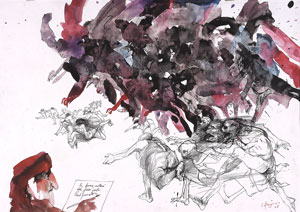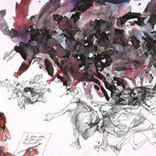was no great fan of Ronald Reagan, but the recent wall-to-wall memorials and testimonials got me thinking about what had been omitted from the weeklong farewell choreography.
I was no great fan of Ronald Reagan, but the recent wall-to-wall memorials and testimonials got me thinking about what had been omitted from the weeklong farewell choreography. Amid the lavish, selective, and often wishful praise for Reagan’s public life, there was not one mention of Reagan’s unique position as our first Post-Modern president. Just as his two-term presidency coincided with the high-water mark of visual Post-Modernism, his long decline into Alzheimer’s corresponded with the increasing irrelevancy of this once-vital aesthetic, to the point where Reagan the hybrid of image and reality seemed to live and die in a conjoined embrace with the picture-of-a-picture worldview of Post-Modernism. Theirs was an odd world of Kabuki synchronicity — Jansenist identities whose outward polarities masked many similarities. In short, I come not to praise or decry Ronald Reagan, but to bury Post-Modernism with him.
I am not trying to suggest that Reagan and the arts were somehow secret sharers — far from it. But there was a time — and that was the time of high post-modernism — when the tactics, strategies, and techniques of the political world and the art world harmonically converged. When I think of Reagan as our ultimate Post-Modernist, I put his oeuvre in the same revolutionary class as Cindy Sherman framing and reframing her identity in terms of photographs that quoted the look (but not the identifying details) of films. It is true that Reagan had much better facilities and a bigger staff and budget than Sherman, but each employed the same terminologies of citational re-creation. Or I think of Richard Prince, rephotographing the Marlboro Man in a cool, decontexualizing embrace that, like Reagan’s often willful conflations of history and imagination, created a distanced, untouchable uber-image, a powerful amnesiac disconnected from content — Morning in America!
Artists like Sherman and Prince shared Reagan’s preoccupation with striking a pose in front of a camera, and they shared his understanding of how this pose could create a palpable sense of reality. But the object lesson of Reagan’s post-modern genius not restricted to photographs. I think of Jeff Koons plating Jim Beam’s J.B. Turner Train commemorative liquor decanter in stainless steel, or arranging vacuum cleaners within coolly lit display vitrines. At their best, Reagan and Koons were all about veneer — both showed a commonplace object (whiskey decanter/washed –up actor) in a new light. Their strategies were simple. Repackage the object — show the object — sell the object.
Just as the futility of trying to extend Reagan’s approach into present politics is apparent, so the visual art strategies of Post-Modernism no longer work. Comparing Reagan’s machinations with those of the current president, what is striking is how apparent and outdated the machinery has become. The packaging and presentation have remained the same, but our eyes have changed. Similarly, the art that speaks best now (and it is a cacophony of competing voices out there) rejects the studied citations of Post-Modernism as academic insincerities. Both Reagan and Post-Modernism have been dying — discretely, bit by bit, and well out of the public eye — for a long time. Reagan’s death from Alzheimer’s, if tragic, was also mercifully and recognizably human. The death of Post-Modernism bears no such humanity, and is such a commonplace that it is hardly mentioned. Those of us who have noticed and who care are lined up behind Lawrence Ferlinghetti, patiently waiting for the eventual “rebirth of wonder” in both politics and art.





3 comments
Just as the futility of trying to extend Reagan’s approach into present politics is apparent, so the visual art strategies of Post-Modernism no longer work.
Comparing Reagan’s machinations with those of the current president, what is striking is how apparent and outdated the machinery has become.
Just as the futility of trying to extend Reagan’s approach into present politics is apparent, so the visual art strategies of Post-Modernism no longer work.